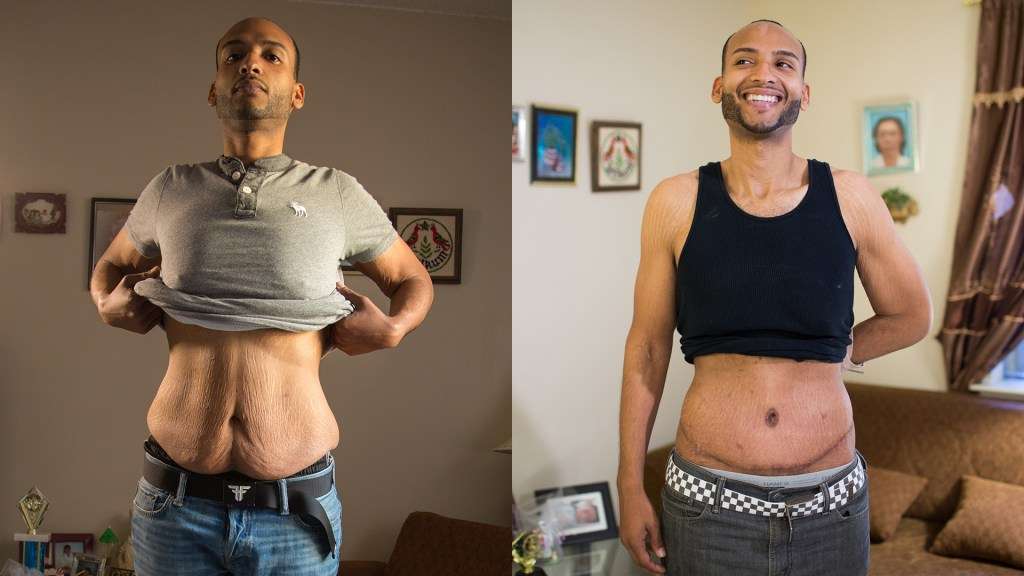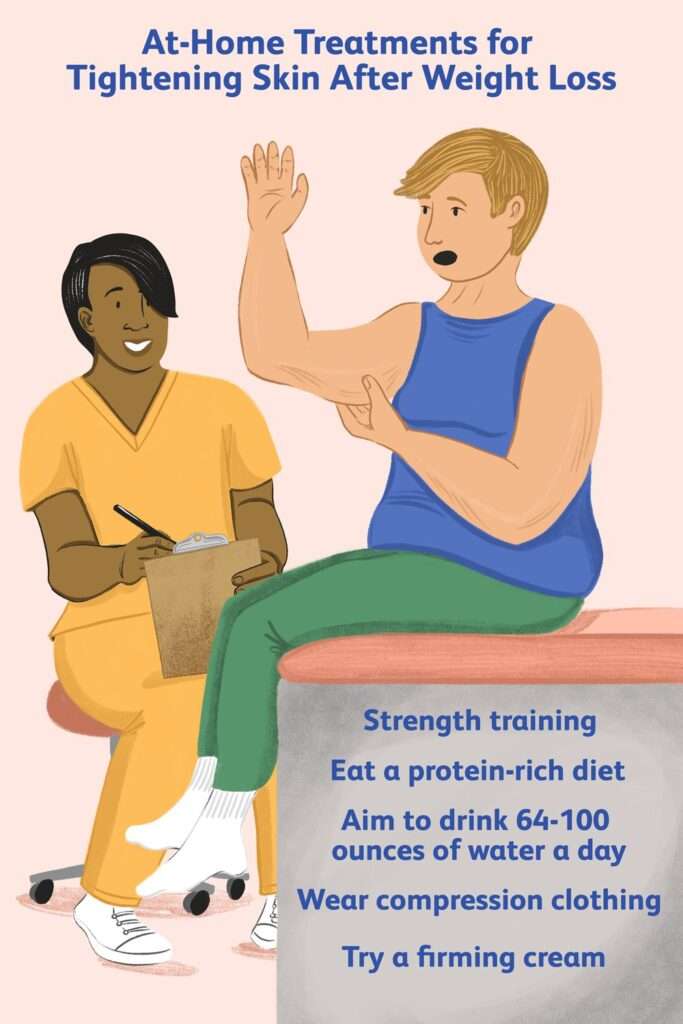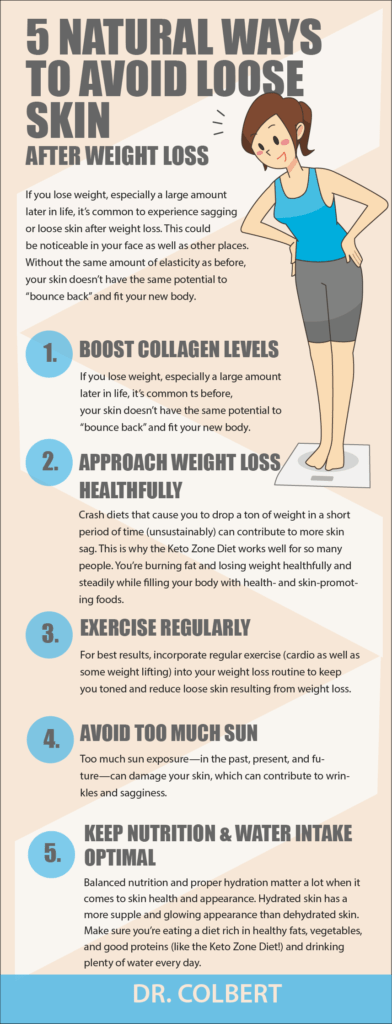Are you trying to lose weight, but worried about ending up with loose skin? Don’t fret, there are strategies you can implement to minimize the likelihood of loose skin during your weight loss journey. In this article, we’ll dive into the topic in detail and provide you with practical tips and techniques to help prevent loose skin along the way.
When you lose a significant amount of weight, your skin doesn’t always shrink along with it. This can result in loose, saggy skin that can be a source of frustration for many individuals. However, there are several things you can do to support your skin’s elasticity and minimize the chances of loose skin. We’ll explore these strategies, such as gradual weight loss, strength training exercises, staying hydrated, and moisturizing, in more depth in the following sections.
By implementing certain lifestyle habits and making conscious choices throughout your weight loss journey, you can give yourself a better chance at maintaining firm and healthy skin. Keep reading to discover how you can take care of your body and minimize the appearance of loose skin, allowing you to feel confident and accomplished in your weight loss achievements. Losing weight is an incredible accomplishment that requires dedication, hard work, and perseverance. However, for many individuals, one of the concerns that often arise during the weight loss journey is the possibility of having loose skin once the excess weight is shed. Loose skin can be a source of insecurity and frustration, but the good news is that there are steps you can take to prevent it or minimize its occurrence. In this article, we will explore various methods and strategies to help you prevent loose skin during weight loss.

Understanding Loose Skin
What causes loose skin during weight loss?
Loose skin occurs when your skin loses its elasticity and is unable to bounce back after significant weight loss. The elastin and collagen fibers in the skin can become damaged or stretched, leading to sagging or loose skin. Various factors contribute to the development of loose skin, including age, genetics, and the amount of weight lost.
How does weight loss affect the skin?
When you lose a considerable amount of weight, whether it is through diet and exercise or through bariatric surgery, the skin that previously stretched to accommodate the extra weight no longer has the same level of fat underneath to support it. As a result, the skin may not retract fully, leading to loose or sagging skin.
Why is loose skin a concern for many people?
Loose skin can cause emotional distress and negatively impact body image, self-esteem, and confidence. It can be demotivating to have worked so hard to lose weight, only to face the challenge of dealing with loose skin. While loose skin is a common occurrence after weight loss, it’s important to remember that there are proactive steps you can take to minimize its occurrence and improve your overall appearance.
Factors Influencing Loose Skin
Age and its impact on skin elasticity
As you age, your skin naturally loses elasticity, making it more prone to sagging. This means that older individuals may be more likely to experience loose skin after weight loss. However, it’s important to note that age is not the sole determining factor, and individuals of all ages can experience loose skin.
Genetics and its role in skin’s ability to bounce back
Genetics play a significant role in determining how well your skin will bounce back after weight loss. Some individuals have more resilient and elastic skin, making them less likely to develop loose skin. However, even if you have less favorable genetics in this regard, there are still steps you can take to improve your skin’s elasticity.
Significant weight loss and its effect on loose skin
The extent of weight loss can also impact the likelihood of developing loose skin. Generally, the more weight you lose, the greater the chance of experiencing loose skin. Losing weight gradually can help minimize the amount of loose skin you may have, as it gives your skin more time to adjust and retract.

Developing a Comprehensive Weight Loss Plan
Gradual weight loss vs. rapid weight loss
When embarking on a weight loss journey, it’s essential to strive for gradual weight loss rather than rapid weight loss. Losing weight at a rate of 1-2 pounds per week is generally considered safe and allows your skin to adjust more effectively. Rapid weight loss, on the other hand, can shock your body and increase the chances of developing loose skin.
Incorporating strength training to build muscle mass
Strength training is a crucial component of any comprehensive weight loss plan, especially when it comes to preventing loose skin. By incorporating resistance exercises into your routine, you can build and tone muscle, which can help fill out your skin and improve its appearance. Strong muscles can provide support to the skin and reduce the appearance of loose skin.
Focusing on overall body composition
Instead of solely focusing on the number on the scale, it is important to pay attention to your body composition. This means aiming to reduce body fat while preserving or increasing muscle mass. As you lose weight and build muscle, your body will become leaner and more defined, reducing the likelihood of loose skin.
Adopting a balanced and nutritious diet
A well-balanced and nutritious diet is crucial for overall health and can also support your skin’s elasticity. Make sure to include plenty of fruits, vegetables, lean proteins, and healthy fats in your diet. These foods provide essential nutrients that support skin health, including vitamins C and E, antioxidants, and omega-3 fatty acids. Additionally, staying hydrated by drinking an adequate amount of water each day can also help maintain skin elasticity.
Hydration and Skincare
Importance of drinking enough water
Proper hydration is key to maintaining healthy, elastic skin. Drinking enough water throughout the day helps your skin stay moisturized and supple. Aim to drink at least eight cups of water per day and adjust your intake based on individual needs.
Moisturizing and nourishing the skin
Regularly moisturizing your skin can help improve its texture and promote elasticity. Look for moisturizers that contain hyaluronic acid, glycerin, or collagen-boosting ingredients. Applying moisturizer while your skin is still damp after showering can help lock in moisture.
Using sunscreen for protection
Sun exposure can damage your skin and contribute to the breakdown of collagen and elastin fibers. Apply a broad-spectrum sunscreen with a minimum SPF of 30 to protect your skin from harmful UV rays. Remember to reapply sunscreen every two hours if you’re spending time outdoors.
Enhancing skin elasticity with targeted products
In addition to moisturizing, using skincare products that target skin elasticity can help improve the appearance of loose skin. Look for products that contain retinol, peptides, or vitamin C, as these ingredients have been shown to promote collagen production and enhance skin elasticity.

Maintaining a Healthy Lifestyle
Regular exercise routines
Regular exercise is not only important for weight loss but also for maintaining healthy skin. Incorporating cardiovascular exercises, such as running or cycling, into your routine improves blood circulation, which can enhance skin health. Aim for at least 150 minutes of moderate-intensity exercise per week.
Getting enough sleep and rest
Quality sleep and rest are essential for your body’s ability to repair and regenerate itself, including your skin. Lack of sleep can lead to increased inflammation and decreased collagen production. Strive to get 7-9 hours of uninterrupted sleep each night.
Avoiding smoking and excessive alcohol consumption
Smoking and excessive alcohol consumption can have a detrimental effect on your skin’s health and elasticity. Smoking restricts blood flow to the skin, leading to reduced oxygen and nutrient supply. Alcohol can dehydrate the skin, making it more prone to sagging. Limit or avoid both of these habits to support your skin’s health.
Stress management and its impact on skin health
Chronic stress can negatively affect your skin by compromising its barrier function and impairing collagen production. Find healthy ways to manage stress, such as practicing yoga, meditation, or engaging in hobbies that bring you joy. Consider incorporating stress-relief techniques into your daily routine.
Non-Surgical Skin Tightening Techniques
Radiofrequency treatments
Radiofrequency treatments use energy to heat the skin and stimulate the production of collagen and elastin fibers. This can help tighten and firm up loose skin. Multiple sessions may be required to achieve desired results.
Ultrasound therapy
Ultrasound therapy, also known as Ultherapy, uses high-intensity focused ultrasound energy to stimulate collagen production in the deeper layers of the skin. The treatment can be effective for improving the appearance of loose skin on the face, neck, and other areas.
Laser skin tightening procedures
Laser skin tightening procedures use laser energy to heat the skin and stimulate collagen production. These treatments can be effective for tightening and firming loose skin on various parts of the body, such as the abdomen, arms, or thighs.

Consulting a Dermatologist or Plastic Surgeon
Assessment of individual skin elasticity
If you are concerned about loose skin during your weight loss journey, it may be beneficial to consult with a dermatologist or plastic surgeon. They can assess your skin’s elasticity and provide personalized guidance and recommendations based on your specific situation.
Professional advice on prevention and treatment
A dermatologist or plastic surgeon can offer professional advice on measures you can take to prevent or minimize loose skin during weight loss. They may recommend specific skincare products, non-surgical treatments, or surgical options, depending on the severity of your loose skin.
Exploring potential surgical options if needed
In some cases, individuals may opt for surgical procedures to remove excess skin and improve body contours. This may involve procedures such as abdominoplasty (tummy tuck), brachioplasty (arm lift), or thigh lift. Surgical options should be discussed thoroughly with a qualified plastic surgeon.
Living with Loose Skin
Acceptance and embracing body positivity
It’s important to remember that loose skin is a physical reminder of your incredible weight loss journey and the progress you have made. Embracing body positivity and accepting your body, including its imperfections, can help you appreciate the incredible feat you have achieved.
Clothing and fashion tips to flatter the figure
Choosing the right clothing and styles can help flatter your figure and minimize the appearance of loose skin. Opt for pieces that provide structure and support, such as well-fitted clothes, compression garments, or shapewear. Selecting styles that draw attention away from areas with loose skin, such as wearing tops with interesting necklines or statement accessories, can also be helpful.
Understanding the psychological impact of loose skin
Dealing with loose skin can be emotionally challenging, but it’s important to remember that your worth and value are not defined by your physical appearance. Seek support from loved ones, join online communities with individuals who have gone through similar experiences, and consider speaking to a therapist if the psychological impact becomes overwhelming.

Importance of Patience and Realistic Expectations
Understanding that skin may not fully bounce back for everyone
While the steps outlined in this article can help prevent or minimize loose skin, it’s vital to understand that everyone’s skin is unique and may respond differently to weight loss. Some individuals may experience more significant improvement in skin elasticity than others. It’s essential to set realistic expectations and focus on the overall health benefits of weight loss.
Being patient with the process
Improving skin elasticity and reducing the appearance of loose skin takes time. Be patient and consistent with your efforts, and remember that results may not be immediate. Continue following a healthy lifestyle, incorporating strength training, and practicing good skincare habits.
Celebrating progress and maintaining a positive mindset
Regardless of whether you have loose skin or not, it’s important to celebrate your progress and maintain a positive mindset throughout your weight loss journey. Focus on the improvements in your health, energy levels, and overall well-being. Embrace self-love and body acceptance, knowing that you are taking steps towards a healthier and fulfilling life.
Conclusion
The journey of weight loss is different for everyone, and loose skin may be a concern for some individuals. However, by taking proactive steps and implementing the strategies outlined in this article, you can minimize the chances of developing loose skin. Gradual weight loss, incorporating strength training, maintaining a balanced diet, and adopting a skincare routine are all essential components of preventing loose skin. Additionally, practicing a healthy lifestyle, exploring non-surgical skin tightening techniques, and seeking professional advice when needed can further support your efforts. Ultimately, the key is to embrace self-love and body acceptance, knowing that the journey towards better health is a lifelong one.
